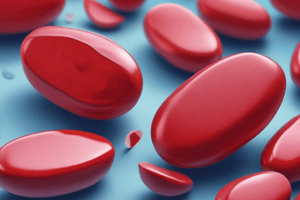Podcast
Questions and Answers
What is the role of Vitamin B12 in the body?
What is the role of Vitamin B12 in the body?
- Assisting with iron absorption in the small intestine
- Aiding in the production of red blood cells in the bone marrow
- Promoting the absorption of folic acid in the stomach
- Protecting the myelin sheath of nerve fibers (correct)
A patient with a history of alcohol use disorder is diagnosed with megaloblastic anemia. Which vitamin is most likely prescribed?
A patient with a history of alcohol use disorder is diagnosed with megaloblastic anemia. Which vitamin is most likely prescribed?
- Folic acid (correct)
- Vitamin B12 (cyanocobalamin)
- Vitamin C (ascorbic acid)
- Iron (ferrous sulfate)
Which instruction should a nurse provide to a patient who is prescribed ferrous sulfate?
Which instruction should a nurse provide to a patient who is prescribed ferrous sulfate?
- Discontinue the medication if nausea occurs.
- Take the medication with orange juice. (correct)
- Increase intake of dairy products to enhance absorption.
- Expect stools to change to a dark green color.
A patient receiving Vitamin B12 reports muscle weakness and palpitations. Which potential adverse effect should the nurse suspect?
A patient receiving Vitamin B12 reports muscle weakness and palpitations. Which potential adverse effect should the nurse suspect?
When administering iron dextran, what is the most critical action for the nurse to take related to potential drug reactions?
When administering iron dextran, what is the most critical action for the nurse to take related to potential drug reactions?
A patient is prescribed cyanocobalamin for treatment of intrinsic anemia. Which intervention is essential for the nurse to include in the plan of care?
A patient is prescribed cyanocobalamin for treatment of intrinsic anemia. Which intervention is essential for the nurse to include in the plan of care?
Which food choice demonstrates a patient's understanding of dietary sources of folic acid?
Which food choice demonstrates a patient's understanding of dietary sources of folic acid?
A elderly patient is newly diagnosed with iron-deficiency anemia. Besides medication, what dietary teaching is most appropriate?
A elderly patient is newly diagnosed with iron-deficiency anemia. Besides medication, what dietary teaching is most appropriate?
A patient is prescribed heparin for a pulmonary embolism. Which of the following instructions should the nurse include in the patient's education?
A patient is prescribed heparin for a pulmonary embolism. Which of the following instructions should the nurse include in the patient's education?
A patient taking warfarin is scheduled for a dental procedure. Which laboratory value is most important for the nurse to review prior to the procedure?
A patient taking warfarin is scheduled for a dental procedure. Which laboratory value is most important for the nurse to review prior to the procedure?
Which of the following is a key advantage of dabigatran (a non-vitamin K antagonist oral anticoagulant) compared to warfarin?
Which of the following is a key advantage of dabigatran (a non-vitamin K antagonist oral anticoagulant) compared to warfarin?
A patient is prescribed clopidogrel after a coronary stent placement. What is a critical instruction the nurse should provide regarding potential adverse effects?
A patient is prescribed clopidogrel after a coronary stent placement. What is a critical instruction the nurse should provide regarding potential adverse effects?
What is the primary reason that thrombolytics, such as alteplase, are considered 'ER medications'?
What is the primary reason that thrombolytics, such as alteplase, are considered 'ER medications'?
Which of the following is a contraindication for the administration of alteplase?
Which of the following is a contraindication for the administration of alteplase?
A patient with a history of AFIB and liver failure is prescribed an anticoagulant. Which medication should the nurse question?
A patient with a history of AFIB and liver failure is prescribed an anticoagulant. Which medication should the nurse question?
Which of the following nursing interventions is most important when caring for a patient receiving heparin therapy?
Which of the following nursing interventions is most important when caring for a patient receiving heparin therapy?
What is a key indication for administering thrombolytic agents?
What is a key indication for administering thrombolytic agents?
What condition should prevent the use of thrombolytic agents?
What condition should prevent the use of thrombolytic agents?
What is a potential drug reaction associated with erythropoietic growth factor (epoetin alfa)?
What is a potential drug reaction associated with erythropoietic growth factor (epoetin alfa)?
For which patient condition is filgrastim primarily used?
For which patient condition is filgrastim primarily used?
What monitoring is crucial for a patient receiving thrombopoietic growth factor (oprelvekin)?
What monitoring is crucial for a patient receiving thrombopoietic growth factor (oprelvekin)?
What should be reported if hemoglobin levels exceed 12g during epoetin alfa treatment?
What should be reported if hemoglobin levels exceed 12g during epoetin alfa treatment?
What is an important baseline lab test for a patient starting filgrastim therapy?
What is an important baseline lab test for a patient starting filgrastim therapy?
Which of the following is NOT a use for epoetin alfa?
Which of the following is NOT a use for epoetin alfa?
Flashcards
Iron-Deficiency Anemia
Iron-Deficiency Anemia
A condition caused by insufficient iron in the body leading to low hemoglobin levels.
Ferrous Sulfate
Ferrous Sulfate
An iron supplement used to treat iron-deficiency anemia.
Vitamin C and Iron
Vitamin C and Iron
Vitamin C enhances the absorption of iron from supplements and food.
Folic Acid Deficiency
Folic Acid Deficiency
Signup and view all the flashcards
Vitamin B12 (Cyanocobalamin)
Vitamin B12 (Cyanocobalamin)
Signup and view all the flashcards
Schilling Test
Schilling Test
Signup and view all the flashcards
Food Sources of Iron
Food Sources of Iron
Signup and view all the flashcards
B12 Deficiency Symptoms
B12 Deficiency Symptoms
Signup and view all the flashcards
Heparin
Heparin
Signup and view all the flashcards
Antidote for Heparin
Antidote for Heparin
Signup and view all the flashcards
Warfarin (Coumadin)
Warfarin (Coumadin)
Signup and view all the flashcards
INR (International normalized ratio)
INR (International normalized ratio)
Signup and view all the flashcards
Dabigatran
Dabigatran
Signup and view all the flashcards
Clopidogrel (Plavix)
Clopidogrel (Plavix)
Signup and view all the flashcards
Alteplase
Alteplase
Signup and view all the flashcards
Safety precautions for anticoagulants
Safety precautions for anticoagulants
Signup and view all the flashcards
Thrombolytic agents
Thrombolytic agents
Signup and view all the flashcards
Indications for thrombolytics
Indications for thrombolytics
Signup and view all the flashcards
Contraindications for thrombolytics
Contraindications for thrombolytics
Signup and view all the flashcards
Erythropoietic growth factor
Erythropoietic growth factor
Signup and view all the flashcards
Erythropoietic reactions
Erythropoietic reactions
Signup and view all the flashcards
Leukopoietic growth factor
Leukopoietic growth factor
Signup and view all the flashcards
Thrombopoietic growth factor
Thrombopoietic growth factor
Signup and view all the flashcards
Monitoring for thrombopoietic therapy
Monitoring for thrombopoietic therapy
Signup and view all the flashcards
Study Notes
Anemia - Iron Preparations
- Ferrous sulfate is used for iron-deficiency anemia. Symptoms include pain, shortness of breath, and dizziness. Causes can be nutritional deficiencies, menstruation, trauma, or bariatric surgery.
- Iron dextran can cause anaphylactic reactions or seizures in some patients. It can also stain teeth. Care is needed to avoid overdosing, especially in children.
- Complete blood count (CBC), hemoglobin (Hgb), hematocrit (HCT), and red cell distribution width (RDW) are checked to evaluate anemia. A low mean corpuscular volume (MCV) indicates iron deficiency.
- Immature white blood cells (bands) and immature red blood cells (reticulocytes) are elevated in some cases of anemia.
- Patients should be advised to take vitamin C with iron supplements for improved absorption. Iron supplements can cause stool to turn black.
- Patients should be advised to eat foods rich in iron such as red meat, whole grains, liver, eggs, and fortified cereals.
Anemia - Folic Acid
- Folic acid is used for megaloblastic (macrocytic) anemia, a condition where red blood cells are larger than normal.
- Causes can include folate deficiency, often associated with alcohol use disorder.
- Drug reactions to folic acid can include yellow urine.
- Folic acid can mask B12 deficiencies. B12 is checked first to avoid incorrect treatment.
- Patients should eat foods rich in folic acid.
Vitamin B12 - Cyanocobalamin
- Vitamin B12 is used for pernicious anemia (lack of intrinsic factor) and to protect the myelin sheath. B12 deficiency damages the myelin sheath.
- Drug reactions can include erythema, hypertension, and hypokalemia.
- Nurses should monitor patients for stomach absorption of B12 with a Schilling test.
- Baseline values for B12, hemoglobin (Hgb), red blood cells (RBC), and reticulocytes are measured every 3-6 months.
- Patients should consume foods high in B12, such as dairy products, eggs, and seafood.
- Patients should be monitored for muscle weakness, nausea, palpitations, and paresthesia.
Venous System - Heparin
- Heparin (factor Xa/thrombin inhibitor) is used for stroke, pulmonary embolism, deep vein thrombosis (DVT).
- Drug reactions may include bleeding and hemorrhage, and low platelet counts.
- The nurse should stop heparin if other, non-heparin medications are needed.
- Monitor activated partial thromboplastin time (aPTT), and watch for bleeding, bruising.
- Protamine is used as an antidote for heparin in case of overdose.
Vitamin K Antagonist - Warfarin
- Warfarin (Coumadin) is used to prevent venous thrombosis, pulmonary embolism, and atrial fibrillation.
- It slows blood clotting.
- Nurses should monitor vital signs, and complete blood counts (INR/PT). This is a critical medication.
- Patients should be advised to avoid dark leafy greens.
Arterial System
- Arterial system medications are used for heart attacks, ischemic strokes, transient ischemic attacks, coronary stents, and related issues.
- Drug reactions can include bleeding (black/dark stool).
- Nurses should monitor platelet counts.
- Patients receiving surgery, should have their medication stopped, if possible.
- Patients should avoid dark leafy greens.
Thrombolytics - Alteplase
- Thrombolytics (e.g., alteplase) are used for acute heart attacks, deep vein thrombosis (DVT), and massive pulmonary embolisms.
- They are used in cases of ischemic cerebrovascular accident (stroke).
- Medical professionals should never administer thrombolytics to a patient with an intracranial bleed.
- Nurses need to ensure rapid initiation of thrombolytic therapy, and control bleeding appropriately.
- These medications are given after patients have already had a stroke/heart attack within a specific timeframe.
Erythropoietic Growth Factor - Epoetin Alfa
- Erythropoietic growth factor (e.g., epoetin alfa) is used to stimulate red blood cell production.
Leukopoietic Growth Factors - Filgrastim
- Leukopoietic growth factors (e.g., filgrastim) stimulate white blood cell production.
- Used for reducing infection risk, bone marrow transplants, chronic neutropenia, and myelosuppressive chemotherapy
- Nurses monitor white blood cell counts (CBC).
- Patients are monitored for leukocytosis (high white blood cell counts), potentially requiring medication adjustment (lowered dose, or stopped medication).
Thrombopoietic Growth Factor - Oprelvekin
- Thrombopoietic growth factors (e.g., oprelvekin) stimulate platelet production.
- Used to treat thrombocytopenia (low platelet count) induced by chemotherapy.
- Nurses should monitor vital signs and complete blood counts, including platelet counts.
- Patients should report any concerning symptoms like bone pain, fever, or stomach pain.
Studying That Suits You
Use AI to generate personalized quizzes and flashcards to suit your learning preferences.



